By Emily Glazer, Maureen Farrell and Margot Patrick
Credit Suisse Group AG amassed more than $20 billion of exposure
to investments related to Archegos Capital Management, but the bank
struggled to monitor them before the fund was forced to liquidate
many of its large positions, according to people familiar with the
matter.
The U.S. family investment firm's bets on a collection of stocks
swelled in the lead-up to its March collapse, but parts of the
investment bank hadn't fully implemented systems to keep pace with
Archegos's fast growth, the people said.
Credit Suisse Chief Executive Thomas Gottstein, and Chief Risk
Officer Lara Warner, who recently departed the bank, only became
aware of the bank's exposure to Archegos in the days leading up to
the forced liquidation of the fund, people familiar with the bank
said. Neither Mr. Gottstein nor Ms. Warner had been aware of the
fund as a major client before that, these people said.
A Credit Suisse spokesman declined to comment.
The exposure reveals for the first time the scope of Credit
Suisse's relationship with Archegos, which unraveled late last
month. Credit Suisse reported a $4.7 billion loss, slashed its
dividend and said Ms. Warner, its investment bank head and other
staff would leave. Credit Suisse is also facing questions from
regulators in the U.S. and Europe about its relationship with
Archegos and the wind down.
Archegos, a U.S. family investment firm of former Tiger Asia
manager Bill Hwang, took huge bets on a few stocks with money
borrowed from banks. When some large positions reversed and
Archegos couldn't meet margin calls, it triggered one of the
biggest sudden losses in Wall Street history.
Archegos spread its bets across a half a dozen banks. Others,
including Nomura Holdings Inc. and Morgan Stanley, also reported
large losses. Credit Suisse lent more to Archegos relative to its
size than other lending banks and was one of the last to exit, The
Wall Street Journal previously reported.
Inside the bank, top management now knows that the so-called
notional exposure, or the underlying value of the assets it managed
on behalf of Archegos, was more than $20 billion, the people
familiar with the matter said.
Some inside the bank who were familiar with Archegos's exposure
had thought it was a fraction of the roughly $20 billion figure,
one of the people familiar with the matter said."
Credit Suisse failed to protect itself from its Archegos
exposure in part because it had not yet instituted a system that
monitored in real time how much risk a position created for the
bank as the prices of the underlying securities changed, people
familiar with the matter said.
This system, known as dynamic margining, wasn't fully
implemented in the division that oversaw Archegos's investments
inside Credit Suisse, the people said. The bank had planned to
migrate the Archegos positions to that system sometime in the
spring, one of the people said.
Archegos made a large portion of its investments through a
derivative called a total return swap. These are contracts brokered
by Wall Street banks that allow a user to take on the profits and
losses of a portfolio of stocks or other assets in exchange for a
fee. Using these swaps, Archegos took big stakes in ViacomCBS Inc.,
Discovery Inc. and a handful of other media and technology
companies, while posting limited funds up front, in essence
borrowing from Credit Suisse and other Wall Street banks.
Because the stock price of many of Archegos' investments were
changing rapidly, Credit Suisse couldn't fully monitor the bank's
own risk without these systems, which are used at many other Wall
Street banks, the people familiar with the matter said.
In the days before banks started rapidly unloading large blocks
of Archegos' holdings or holdings related to its swaps, executives
inside Credit Suisse clashed over when and how aggressively to
sell, some of the people said. Goldman Sachs Group Inc. and Morgan
Stanley were relatively quick to move large blocks of assets, as
the scale of the hedge fund's losses became apparent.
Credit Suisse reports first-quarter earnings on Thursday, when
it is expected to publish more details about the overall damage
Archegos had on its finances.
The Archegos crisis emerged just weeks after Greensill Capital,
a U.K. finance firm that was deeply entangled with Credit Suisse,
filed for insolvency and left the bank on the hook for losses.
Credit Suisse has said its dealings with both Archegos and
Greensill need "substantial further review and scrutiny." It said
its board formed a crisis team and hired outside help to
investigate.
The investigations will also examine how the bank, after pouring
huge amounts of investment into risk controls and oversight in
recent years, allowed itself to get involved in both situations. In
the case of Greensill, the bank reviewed the relationship multiple
times in recent years, but continued to expand its business with
the company.
Juliet Chung contributed to this article.
Write to Emily Glazer at emily.glazer@wsj.com, Maureen Farrell
at maureen.farrell@wsj.com and Margot Patrick at
margot.patrick@wsj.com
(END) Dow Jones Newswires
April 21, 2021 19:14 ET (23:14 GMT)
Copyright (c) 2021 Dow Jones & Company, Inc.
Credit Suisse (NYSE:CS)
Historical Stock Chart
From Mar 2024 to Apr 2024

Credit Suisse (NYSE:CS)
Historical Stock Chart
From Apr 2023 to Apr 2024
